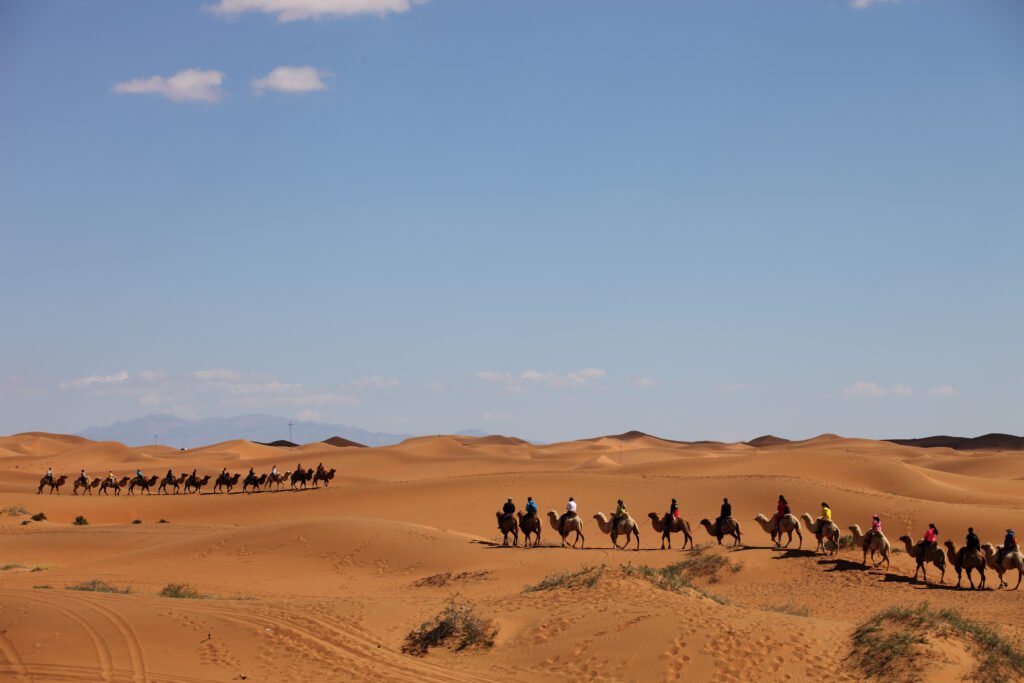The Silk Road, often romanticized as an ancient network of trade routes, holds a pivotal place in history. Stretching from China to Europe, this intricate web of paths not only transported goods like silk, spices, and precious metals but also carried ideas, culture, and innovation. The influence of the Silk Road extends far beyond its historical heyday, deeply shaping the modern world. From global trade to cultural integration, its legacy is embedded in the fabric of contemporary society
What Was the Silk Road?

The Silk Road was not a single, continuous route but a series of interconnected trade paths. It emerged during the Han Dynasty (circa 130 BCE) and facilitated exchanges between the East and West for centuries. The term “Silk Road” was coined in the 19th century by German geographer Ferdinand von Richthofen to emphasize the prominence of silk in these trade routes. However, silk was just one of many goods traded, with items like spices, paper, ceramics, and even ideas flowing along this route.
Economic Impact: Origins Modern Global Trade

1. Birth of International Commerce
The Silk Road established the concept of international trade, linking economies across continents. Merchants and traders exchanged not only goods but also knowledge about market demands and business practices, laying the groundwork for the globalized economy we see today. For instance, the use of credit notes and banking systems resembles modern financial systems, reducing the need for traders to carry large sums of money. These early innovations influenced the development of contemporary banking and trade mechanisms
2. Introduction of Luxury Goods
Luxury goods like silk, spices, and porcelain gained immense popularity in Europe, creating a high demand for imported items. This demand shaped trade policies and even led to the Age of Exploration, as European powers sought direct access to Eastern markets.
If we look at modern world, the desire for exotic goods persists in today’s world, driving international trade. Products like electronics, luxury fashion, and specialty foods continue to bridge global markets, much like silk and spices once did.
Cultural Exchange: The Silk Road as a Channel of Ideas
1. Spread of Religion
Major religions like Buddhism, Christianity, Islam, and Zoroastrianism were spread and introduced in far off areas. Monks and missionaries traveled these routes, spreading teachings and philosophies. For example, Buddhist art and texts found their way to China from India, significantly influencing Chinese culture and religious practices.
2. Art and Architecture
Artifacts unearthed from Silk Road hubs reveal how cultural exchange influenced art, music, and architecture. Chinese ceramics, Persian rugs, and Roman glassware were admired and emulated across different regions which helped promote trade and tolerance.
Technological Advancements: Seeds of Modern Innovation
1. Paper and Printing
The Silk Road introduced paper from China to the Middle East and Europe. This revolutionary invention transformed communication, education, and governance. By the 15th century, the printing press further democratized knowledge, paving the way for the modern information age.
Today, the internet functions as a digital Silk Road, spreading knowledge instantaneously across the globe. The principles of accessible information can trace their roots back to this early exchange of paper technology.
2. Gunpowder and Military Strategy
Another transformative innovation was gunpowder. It revolutionized warfare and had a profound impact on global geopolitics.
The transfer of technology across borders remains a cornerstone of innovation. From space exploration to artificial intelligence, international collaboration owes much to the spirit of exchange that characterized the Silk Road.
Influence on Modern Connectivity
1. Inspiring Modern Infrastructure
The interconnectedness of the Silk Road has inspired modern infrastructure projects like China’s Belt and Road Initiative (BRI). This ambitious effort aims to create new trade routes by investing in transportation, energy, and communication networks across Asia, Europe, and Africa.
Relevance to the Modern World:
The BRI reflects the enduring value of connectivity. By improving trade routes, nations can foster economic growth and cultural exchange.
2. Digital Silk Roads
In the 21st century, the concept of the Silk Road has evolved into a digital format. The internet and global e-commerce platforms enable the exchange of goods, services, and information at unprecedented speeds. Companies like Alibaba and Amazon embody this modern transformation, connecting suppliers and consumers worldwide.
Environmental Lessons

1. Sustainability Challenges
The heavy use of Silk Road routes led to overgrazing, deforestation, and the depletion of resources in some areas. These historical challenges remind us of the environmental costs of economic development.
Modern Takeaway:
Balancing economic growth with sustainability is critical. The lessons of past urge us to prioritize eco-friendly practices in trade and infrastructure development.
2. Cross-Border Collaboration
Cooperation between regions to address environmental and logistical challenges, a practice still relevant in tackling global issues like climate change.
The Silk Road’s Cultural Legacy
1. Culinary Exchange
The Silk Road introduced diverse cuisines to new regions. Spices from India and the Middle East enriched European diets, while Chinese tea became a global phenomenon.
Modern Culinary:
Fusion cuisines—like Indo-Chinese or Mediterranean-American—are modern reflections of the culinary exchanges that began along the Silk Road.
2. Fashion and Textiles
Silk revolutionized fashion in Europe and beyond. The demand for this luxurious fabric influenced trade routes, economies, and even diplomatic relations.
Contemporary Impact:
The global fashion industry continues to draw inspiration from Silk Road cultures, with designs showcasing Eastern patterns and materials in Western markets.
Challenges of the Silk Road
1. Political Instability
Throughout history, political conflicts and changing empires disrupted trade along the Silk Road. These challenges underline the importance of stability for economic prosperity.
2. Disease Transmission
The Silk Road also facilitated the spread of diseases like the Black Death, highlighting the double-edged nature of interconnectedness.
Modern Parallels:
The contemporary world, global trade and travel bring both economic benefits and challenges like pandemics, emphasizing the need for robust health systems and international cooperation.
Conclusion: The Silk Road’s Timeless Influence
The Silk Road was more than a trade route; it was a bridge between civilizations, laying the groundwork for the interconnected modern world. Its legacy lives on in today’s global economy, technological advancements, cultural exchanges, and even environmental awareness.



This piece is a perfect blend of intellect and heart. The ideas you present are complex, but you navigate them with such ease that it feels like you’re inviting the reader to walk alongside you, step by step, through a maze of thought and emotion. It’s the kind of writing that challenges you and comforts you all at once.
whoah this weblog is fantastic i like reading your posts.
Keep up the good work! You understand, lots of people are hunting
around for this information, you can aid them greatly.